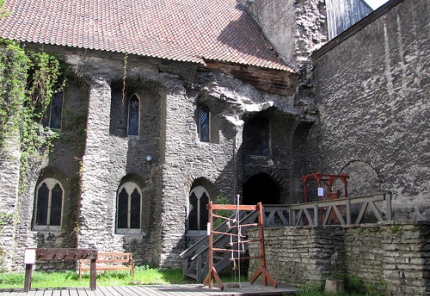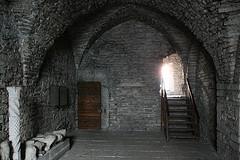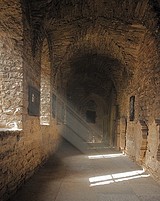

Vene 16/ 18
Tel. 515 5489
Bus: 5, 40
Trolley: 1, 2, 3, 4
Open: May- Sept 10am- 6pm daily
Dominican Monastery Museum
Open: mid- May- mid- Sept 10am- 6pm daily
www.kloostri.ee
Saint Catherine's Monastery (also Catherine's Monastery and Dominican
Monastery) was a monastery dedicated to Catherine of Alexandria in the
present-day Tallinn Old Town. It was founded and built in 1246 by the
Dominican order.
The official and also the oldest name of the
Dominican monastery in Tallinn was the monastery of the Order of
Preachers in Tallinn. In official documents, the names Preachers'
Brothers Monastery, Black Monastery, Black Monks Monastery and St.
Catherine's Black Monks Monastery are also found, but the most common
name is simply Monks Monastery, because the Dominican Monastery was the
only monastery in Tallinn. The monastery building is also called
Mungahoov.
The monks of the monastery were sometimes called St.
Catherine's Black Monks and Preacher Brothers, but also simply monks.
The most common name is the black monks, both the monks and the
monastery got the name black from the black clothing of the monks.
The buildings of St. Catherine's monastery together with the
Catholic Tallinn Peter-Paul Cathedral have been recognized as cultural
monuments.
The Dominicans arrived in Tallinn in 1229, after the Order of the
Sword Brothers had captured the last Estonian fortress in 1219. The
document confirming the establishment of the Tallinn monastery has not
been preserved, but reliable data can be obtained from the chronicle of
the Danish chronicler Isacus Pontus (also known as Pontanus), in which
he notes that the Danish king Waldemar II sent monks of the Dominican
order (who were active in Denmark from 1221) on the recommendation of
the papal legate William of Modena ) also in Tallinn. They were probably
Danish monks, through whom the Danish king hoped to protect and
consolidate his power. An important role was also played by the former
bishop of Ribe, Tuve, who was appointed as the deputy administrator of
the Danish king in Tallinn - state keeper (1222-1233). He was the one
who led the mission activities in Estonia when he was stationed in the
Tallinn fortress.
The first Dominican wooden church was probably
built on the site of the current Tallinn Cathedral (the side walls of
the choir room of the Cathedral still contain the remains of this oldest
church) and the other necessary monastery buildings were also built in
Toompea, to the north of the Small Castle and to the east of the defense
ditch of the Great Castle, i.e. on the land belonging to the bishop,
i.e. the Great Castle. The culmination of the power struggle between the
clerical and secular authorities in Toompea also took place in the
original wooden church. Alna Balduin, the papal legate, wanted to
subject Toompea to the papal rule in addition to Northern Estonia, which
was the main reason why a bloody battle broke out between the brothers
of the order and the vassals of the Danish king and the pope in 1233.
According to the chronicler, the vassals who fled to the church were
killed right in front of the altar, and neither the bishop nor the
clergy were spared. The settlement of the Dominicans, established soon
after, was destroyed during the conflict between the Danes and the Order
of the Brothers of the Sword.
In 1246, 11 monks from Danish and
Swedish monasteries arrived in Tallinn by order of the provincial
chapter of Ribe. They were led by Prior Daniel (of Visby), who had
survived the battle of 1233. Since the church in Toompea had been
converted into a cathedral in 1240, a place with a relatively high and
decent base under the eastern side of the city, in the area between the
city guard and the sea, between the current Vene Street and the city
wall, was chosen as the new location of the monastery. At that time,
Tallinn's city wall ran from the higher point of today's Pühvaimu Street
across the current Apteeg Street and from there to the neck of Vanaturu.
In the 13th century, the coastline of Tallinn Bay was only a hundred
meters to the east of the city wall, which has survived to this day, and
the new location of the monastery on the road that connected the busy
harbor and the Old Market located in front of the Vanaturu neck at that
time, was favorable for missionary activities and also aligned with the
order's economic interests. On the plot next to the monastery was the
Tallinn trade yard of the Kolga economic center of the Dominican order
Roma monastery, where the products of the economic center were realized,
and in the corner building of Vene 8 and Pühavaimu 15 was the plot of
the Kärkna monastery of the Cistercian order.
The new Dominican
monastery consisted of St. Catherine's church and cloister buildings
(now on the property of Vene 16), which were located around a square
courtyard, and auxiliary buildings of the monastery: the monastery barn,
brewery, stables, etc.
At the same time as the monastery, a school was also established in
Tallinn. The school was divided into the so-called outer and inner
school. The first one was intended for the clergy, the second one
provided education for the laity, including Latin-language education for
boys from the countryside. The first information about the existence of
the so-called external school dates back to 1319. The new monastery was
founded in 1246.
During the activity of the monastery
(1246–1525), lay residents could not enter the building of St.
Catherine's monastery. The only exception was the monastery church,
where everyone could come to listen to sermons.
The Dominicans
tried to communicate directly with the community. In order to explain
religious truths to the people, several monks learned the Estonian
language and were popular among the rural people as well as urban
Estonians.
The main income for the monastery came from interest on real estate, less often they also engaged in the sale of foodstuffs, domestic animals and shoes. Connections with the Tallinn Blackheads brotherhood were important: the brotherhood made material donations to the monastery, but in return the monks prayed for the brotherhood members. In addition, the monastery residents bought fish from fishermen and sold it to local feudal lords. The income was used to buy agricultural products. The monastery also received income from the sale of beers brewed in the monastery.


In 1523, the Tallinn Council adopted the idea of the reformation
movement, as a result of which the holding of Catholic masses in the
lower city was interrupted. The following year, there was a looting of
images in the city, as a result of which mobs broke into the monastery
and forced the monks to leave the city.
The activities of the
Order of the Dominicans, or Preachers, were terminated by the decision
of Tallinn City Hall on January 12, 1525, and the property of the Order
and St. Catherine's Monastery was declared the property of the city.
Since the monastery management did not hand over the property
voluntarily, the church management consisting of prior Augustinus
Emsinckhoff, lector and subprior Thomas de Reken, and procurator David
Sliper were taken into custody.
After the Reformation in Tallinn,
the monastery buildings remained in use by the city.
In a fire in
Tallinn in 1531, the church of the monastery and part of the buildings
of the east and north wings were destroyed, but the Monastery Barn was
not so badly damaged. After the fire, the invalids and the poor of the
city settled in the ruins of the monastery.
In the 18th century,
a school operated in the old dormitory⁷, which was later handed over to
the Roman Catholic Church. In connection with the construction of the
Peter-Paul Church in Tallinn in 1841-1844, the old wing building was
demolished.
The most powerful building of the monastery complex was the
three-nave St. Catherine's Church located in its southern part
(currently on plot 12/14 of Vene), which was probably completed in its
final form in the second half of the 14th century and was the largest
church building in the medieval Tallinn under-city. The length of the
church was 67.7 and the width was 18.5 meters, while the area was 1219
square meters.
The monastery church was also unique in that it
also housed a crypt.
In 1544, the former granary of the monastery was turned into a city
armory. The building was used for this purpose for two and a half
centuries, and reconstructions were also made: the south wall of the
second floor was built with representative sash windows for better
lighting of the armory, and oak gates were installed on the two main
portals of the west facade. The latter are one of the oldest both in
Tallinn and in the whole of Estonia, and they also stand out for their
unique forges.
In 1804, the Tallinn Council handed over the
premises used as an arsenal to the authorities of the Russian Empire,
but in the middle of the 19th century, Tallinn Fortress was excluded
from the list of Russian fortresses and the armory was sold to private
individuals.
The buildings were originally acquired by the Girard
de Soucantons, and from 1869 until World War II, they belonged to the
Kochs, who owned all the buildings at 12-14 Vene Street.
In 1938,
according to the designs of the architect Erich Jacoby, reconstructions
were made in the monastery's granary building, which strengthened the
building's structures and improved the general impression. Workshops and
a garage were located on the first floor of the barn building, an office
and warehouse on the second floor, a warehouse on the third floor, and
later also an office.
The Dominican Monastery Museum operated in the former monastery
premises belonging to the Tallinn Peter-Paul Church of the Roman
Catholic Church and in the east wing of the monastery.
Today,
only the eastern wing or cloister building is used as a museum and is
managed by the Mauritius Institute (www.1246.eu).
Its two rooms
(dormitory and chapter hall) are usually exhibition halls, in the
cloister and chapel you can see medieval inscriptions deposited there by
the Tallinn City Museum.